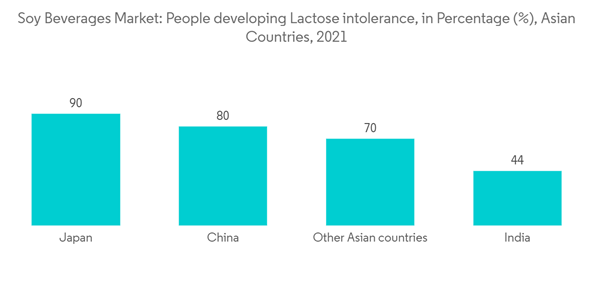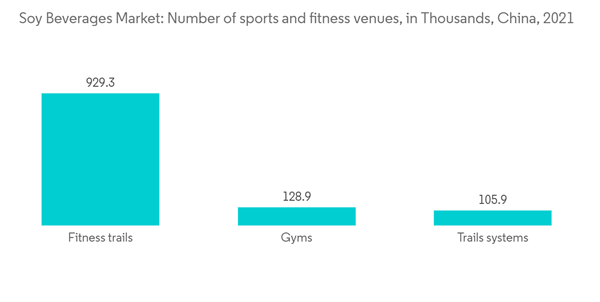Key Highlights
- The increased availability of soy beverages and the scientifically proven health benefits associated with soy consumption, such as reducing blood cholesterol and lowering the risk of certain cancers, can be attributed to the higher consumption of soy-based products. These products are becoming increasingly popular among people interested in adopting plant-based diets and are a thriving segment of the food and beverage industry.
- Soy-based products are considered to be rich in nutritional content, including carbohydrates, protein, and omega-3 fatty acids, and contain no cholesterol, making them an attractive option for health-conscious consumers. This trend is particularly prominent in China, where soy-based products are gradually becoming a significant part of the diet.
- In this market, international brands have a strong consumer base, with companies like The Hershey Company introducing new flavors like "Coffee Mocha" to its portfolio of "Sofit" beverages, which are soy milk drinks. These products cater to a larger audience while providing health benefits to the consumers. The Hershey Company's soy beverage products are available at various online and offline stores in China.
- Moreover, private-label brands in the region have also contributed to the growth of soy products, driven by the changing retail environment. The market is expected to expand further in the projected period due to rising demand and the establishment of numerous medium-sized businesses in the area.
- However, one of the market restraints is the high production cost of dairy substitutes/alternatives. Nonetheless, the growing trend of adopting plant-based diets and the increasing awareness of the health benefits associated with soy consumption is likely to continue driving the growth of soy-based products in the food and beverage industry.
China Soy Beverages Market Trends
Increasing Demand for Plant-based Products Due to Raising Lactose Intolerance
- The rising awareness and interest in the vegan lifestyle and animal product allergies are driving the demand for plant-based products in China. The use of plant proteins in nutritional and dietary supplements is common, and the prevalence of health disorders like obesity creates favorable opportunities for the soy beverages market in China. Traditional and alternative medicines that rely on herbal and plant ingredients are also popular in China, making it a suitable market for new and innovative plant-based products made from soy.
- In addition, the increasing incidence of lactose intolerance and the ongoing vegan trend have prompted consumers to seek lactose-free dairy substitutes derived from plant sources. Dairy products are often avoided due to lactose intolerance and allergies, with cow milk allergy being one of the most prevalent food allergies in infants and young children.
- For instance, according to Britannica ProCon.org, in July 2022, 85% of the Chinese population suffers from lactose intolerance. The increased awareness of the health benefits of plant-based food and beverages through social media platforms and advertisements has led to a surge in demand for vegan food and beverages in China.
Health and Wellness Trend Driving the Market Growth
- Soy beverages are gaining popularity among individuals, particularly athletes involved in physical fitness activities. The millennial population is driving the market due to their interest in sports, inclination toward fitness, higher buying capacity, and willingness to purchase healthy products.
- As consumer trends shift, soy beverage manufacturers are evolving new products to meet consumer interests. The growing interest in physical fitness, and the rise of health clubs and fitness centers, have also emerged as drivers for the soy beverage market.
- For instance, China has seen a surge in the number of sports and fitness facilities, with approximately 129,000 gyms as of December 2021, according to the State General Administration of Sports. As the Chinese population becomes more health-conscious, this trend is expected to continue. In addition, with the increase in lifestyle diseases and the aging population, consumers are leaning towards functional foods that offer a broad spectrum of health benefits. As a result, the market for soy beverages in China is being driven by consumers who prefer low-calorie, high-protein, organic, and free of artificial additives beverages. The consumption of soybean is also driving soy beverage consumption in the region.
- Furthermore, soy-based beverages are believed to promote heart and brain health, as well as reduce menopause symptoms. As customers become more aware of the numerous advantages of dairy-free diets, they are transitioning to dairy-free products, such as soy beverages. The market for soy beverages is expected to grow over the forecast period due to increasing consumer awareness of the benefits of soy beverage products and their increased availability.
China Soy Beverages Industry Overview
The market for soy beverages is highly consolidated, with several major players adopting various strategies to increase their market share. To expand their geographical reach and customer base, key players are focusing on mergers and acquisitions. Additionally, product innovation is a popular strategy adopted by companies operating in the market, along with expansions, to increase their visibility and portfolio of offerings. The introduction of new soy beverages is providing significant growth opportunities for this market. The major players in this market include Danone SA, Kikkoman Pearl Soy Milk, The Hain Celestial Group, Dali Foods, and Vitasoy International Holdings Ltd, among others. Both domestic and international players are dominating China's soy beverages market, leading to an increase in competition.Additional Benefits:
- The market estimate (ME) sheet in Excel format
- 3 months of analyst support
This product will be delivered within 2 business days.
Table of Contents
Companies Mentioned (Partial List)
A selection of companies mentioned in this report includes, but is not limited to:
- Danone SA
- Kikkoman Pearl Soy Milk
- The Hain Celestial Group
- Dali Foods
- Vitasoy International Holdings Ltd
- Organic Valley
- VinaSoy










